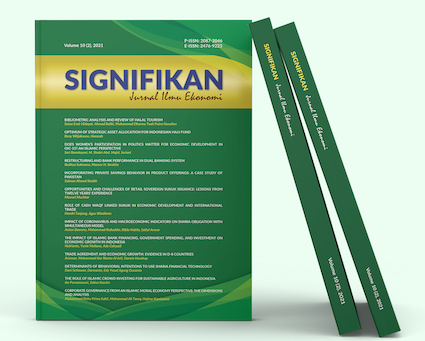Does Women’s Participation in Politics Matter for Economic Development in OIC-15? An Islamic Perspective
DOI:
https://doi.org/10.15408/sjie.v10i2.20214Keywords:
Female participation in politics, Trade Balance, Islamic Human DevelopmentAbstract
This study aims to empirically determine and analyze the role of women's participation in politics, female population growth, trade balance, and women's labor force participation in promoting economic development across 15 OIC countries during the 2006-2017 period, both in short- and long-run from an Islamic perspective. Using the Panel Autoregressive Distributed Lag (ARDL) method, this study found that, in the short term, trade balance and women's labor force participation have promoted Islamic economic development. In contrast, women's participation has a negative effect on the economic development of OIC countries. In the long term, on the other hand, all variables have promoted Islamic economic development in OIC countries, except for the trade balance variable. These findings suggest that coordination and synergy for strengthening economic development among OIC countries need to be enhanced, focusing on women's role in politics, labor force, quality of population, and economic dimensions.JEL Classification: C33, F16, J16, O11, P48
Ramdayani, S., Majid, M. S. A., & Suriani, S. (2021). Does Women's Participation in Politics Matter for Economic Development in OIC-15? An Islamic Perspective. Signifikan: Jurnal Ilmu Ekonomi, 10 (2), 209-222. https://doi.org/10.15408/sjie.v10i2.20214.
References
ADB. (2018). Kazakhstan Country Gender Assessment. Metro Manila, Philippines: Asian Development Bank. https://doi.org/http://dx.doi.org/10.22617/TCS179181.
Almizan. (2016). Economic Development in Islamic Economic Perspective. Maqdis: Journal of Islamic Economic Studies, 1(2), 1–20.
Bank Negara Malaysia. (2007). The Malaysian Economy in 2007. Retrieved from https://www.bnm.gov.my/documents/20124/830573/cp01.pdf
Anto, H. (2011). Introducing an Islamic Human Development Index ( I-HDI ) to Measure Development in OIC Countries. Islamic Economic Studies, 19(2), 69–95.
Bullough, A., Kroeck, K. G., Newburry, W., Kundu, S. K., & Lowe, K. B. (2012). Women’s Political Leadership Participation Around the World: An Institutional Analysis. The Leadership Quarterly, 23(3), 398–411. https://doi.org/10.1016/ j.leaqua.2011.09.010
Cabeza-garc, L., Brio, E. B. Del, & Oscanoa-victorio, M. L. (2018). Gender Factors and Inclusive Economic Growth: The Silent Revolution. Sustainability, 10(121), 1–14. https://doi.org/10.3390/su10010121.
COMCEC. (2017). Comcec Trade Outlook. Ankara, Turkey: Commercial Cooperation of the Organization of Islamic Cooperation.
Commission Staf Working Document. (2008). Albania 2008 Progress Report. Brussels: Commission of The European Communities.
Fadilah, K. (2019). Pengaruh Pertumbuhan Ekonomi, Islamic Human Development Index, dan Pengangguran terhadap Kemiskinan: Studi pada Kabupaten/Kota Daerah Istimewa Yogyakarta Tahun 2010-2018. (Unpublished Thesis). Universitas Islam Negeri Syarif Hidayatullah Jakarta.
Fadlan. (2010). Konsep Pembangunan Ekonomi Berbasis Islam: Sebuah Upaya Pembangunan Ekonomi Indonesia yang Adil, Makmur, dan Sejahtera. Al-Ihkam, 5, 257–274.
Faizul, M., Matin, M. A., Nadzrah, A., & Mohammad, R. (2020). Women’s Participation in Education and Politics: Evidence from the Selected OIC Countries. Social and Political Sciences, 3(3), 776–788. https://doi.org/10.31014/aior.1991.03.03.210
Fatima, A., & Sultana, H. (2009). Tracing Out the U-shape Relationship Between Female Labor Force Participation Rate and Economic Development. International Journal of Social Economics, 36, 182–198. https://doi.org/10.1108/03068290910921253
Hadi, A. (2017). Posisi Wanita dalam Sistem Politik Islam Perspektif Fenomelogi. An Nisa’a: Jurnal Kajian Gender Dan Anak, 12(01), 9–20.
Hasanah, U., & Musyafak, N. (2017). Gender and Politics: Keterlibatan Perempuan dalam Pembangunan Politik. Sawwa: Jurnal Studi Gender, 12, 409–432.
Islam, M. M. (2017). Rapid Fertility Decline in Oman: Understanding the Role of Proximate Determinants. Middle East Fertility Society Journal, 22(4), 275–284. https://doi.org/10.1016/j.mefs.2017.04.007
Khorsheed, E. (2019). Women Parliamentarians Impact on Economic Growth: A Cross-Country Analysis Evidence. Proceeding International Conference on Modeling Simulation and Applied Optimization (ICMSAO) (pp. 1–5). IEEE. https://doi.org/https://doi.org/10.1109/ICMSAO.2019.8880280
Mujahid, N., & Zafar, uz N. (2012). Economic Growth-Female Labour Force Participation Nexus: An Empirical Evidence for Pakistan. The Pakistan Development Review, 51(04), 565–585.
OIC. (2017). OIC Economic Outlook. Oran, Ankara- Turkey: OIC.
OIC. (2018). OIC Women and Development Report. Oran, Ankara- Turkey: OIC.
Ramadani, V. (2015). The Woman Entrepreneur in Albania : An Exploratory Study on Motivation Problems and Success Factors. Journal of Balkan and Near Eastern Studies, 17(2), 204–221. https://doi.org/10.1080/19448953.2014.997488
Rochmawati, T. (2018). Analisis Islamic Human Development Index (I-HDI) di Kota Yogyakarta Tahun 2015-2016 dalam Perspektif Maqashid Syariah. (Unpublished Thesis). Universitas Islam Indonesia.
Ustabas, A., & Gulsoy, T. Y. (2020). The Relationships between the Female Labor Force Participation Rate and Economic Development: A Correlation Analysis for Turkey. Proceeding International Conference on Eurasian Economies, 104–113.
Warjiyati, S. (2016). Partisipasi Politik Perempuan Perspektif Hukum Islam. Al-Daulah, Jurnal Hukum Dan Perundangan Islam, 6(01), 1–27.
World Bank. (2020). World Bank Gender Statistics-Proportion of seats held by women in national parliaments (%), 2020. Retrieved from https://data.worldbank.org/indicator/ SG.GEN.PARL.ZS
Xu, L. (2015). Effects of Female Political Participation on Economic Growth: Evidence from Asian Countries. (Unpublished Thesis). Lund University.

